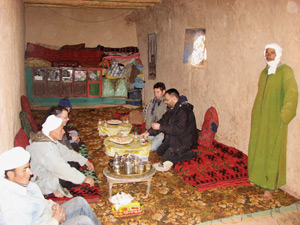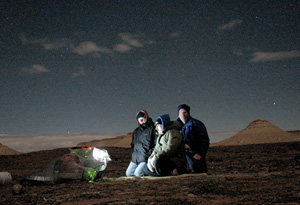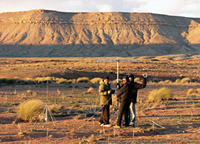 |
 |
| Top: Scientists and team members scouting locations in Morocco take advantage of a local shepherd's hospitality. Bottom: Engineers camp out in the Moroccan desert to search for radio wave signals. |
| Photos courtesy of Dave McGinnis |
A desert quest for no-cell-phone zone
It seemed like a mirage: A shepherd holding a silver tea service crossing barren desert to quench the thirst of strangers.
In their search for a quiet place to build a telescope that will make a 3D map of the universe, Fermilab's Ralph Pasquinelli and Dave McGinnis had entered a different world.
“That area made the Mars landscape look hospitable,” McGinnis says.
The two engineers from Illinois had traveled over the Atlas Mountains and through roadless areas of the Sahara desert to the most remote region of Morocco. They endured rain, snow, and blowing sand, and sometimes had to scout on foot for passages suitable for their four-wheel-drive vehicle loaded with 300 pounds of test equipment.
The inhabitants of the area herd goats and sheep. There are no villages, government offices, electricity, or running water. “These people are living the way they did for hundreds of years,” Pasquinelli says.
While local people do have cell phones, signal towers are scarce, making this a perfect location for a radio telescope that needs to operate free from interference by radio waves.
The proposed telescope project would use a new strategy to measure the collective emissions of hydrogen in many galaxies at once with unprecedented precision and efficiency. The resulting map should reveal the frozen ripples of cosmic sound waves whose travels through the early universe were shaped by dark energy.
 |
| Fermilab engineers set up equipment to search for radio wave signals that could interfere with the proposed experiment. |
| Photo courtesy of Dave McGinnis |
“By measuring the density fluctuations of the universe in 3D, we can hope to understand more about dark energy,” McGinnis says. Scientists believe dark energy could explain why the universe is expanding today.
The proposed $20 million to $25 million telescope could be built by a collaboration between Fermilab, Carnegie Mellon University, CEA-Saclay and Orsay labs in France, and Morocco's Al Akhawayan University, which would run the telescope. Proponents hope to get funding from Arab states.
“It is really exciting for Morocco, a developing country, to have this scientific instrument in their back yard,” Pasquinelli says. “This would really help to bolster their economy,” bringing in roads, water, and other infrastructure and perhaps attracting businesses.
The telescope might even sit on the grazing land of the shepherd who walked three kilometers to their work site to greet them with tea and, according to ancient custom, offer his one-room home for breakfast and lodging.
Rhianna Wisniewski
Click here to download the pdf version of this article.






